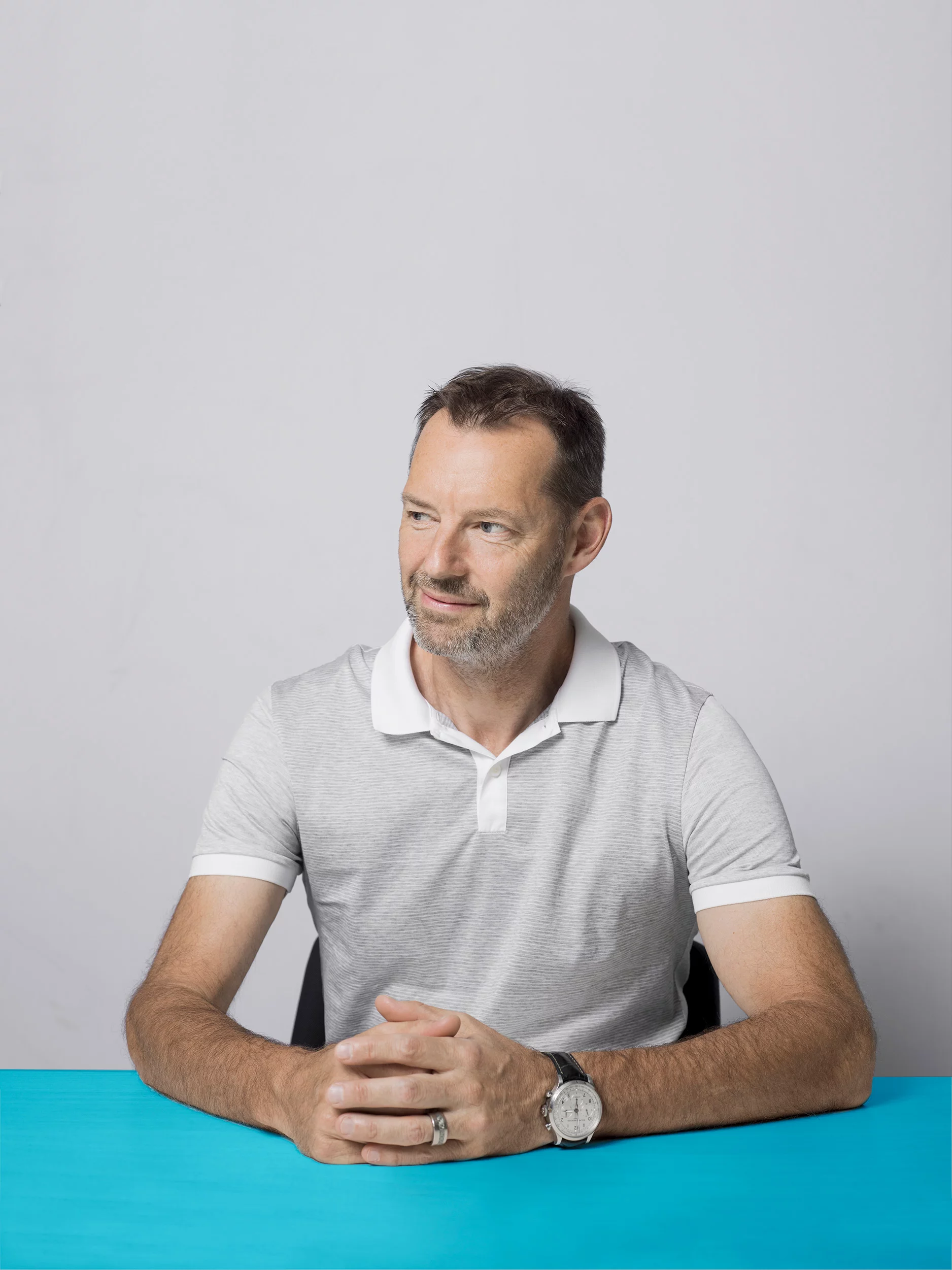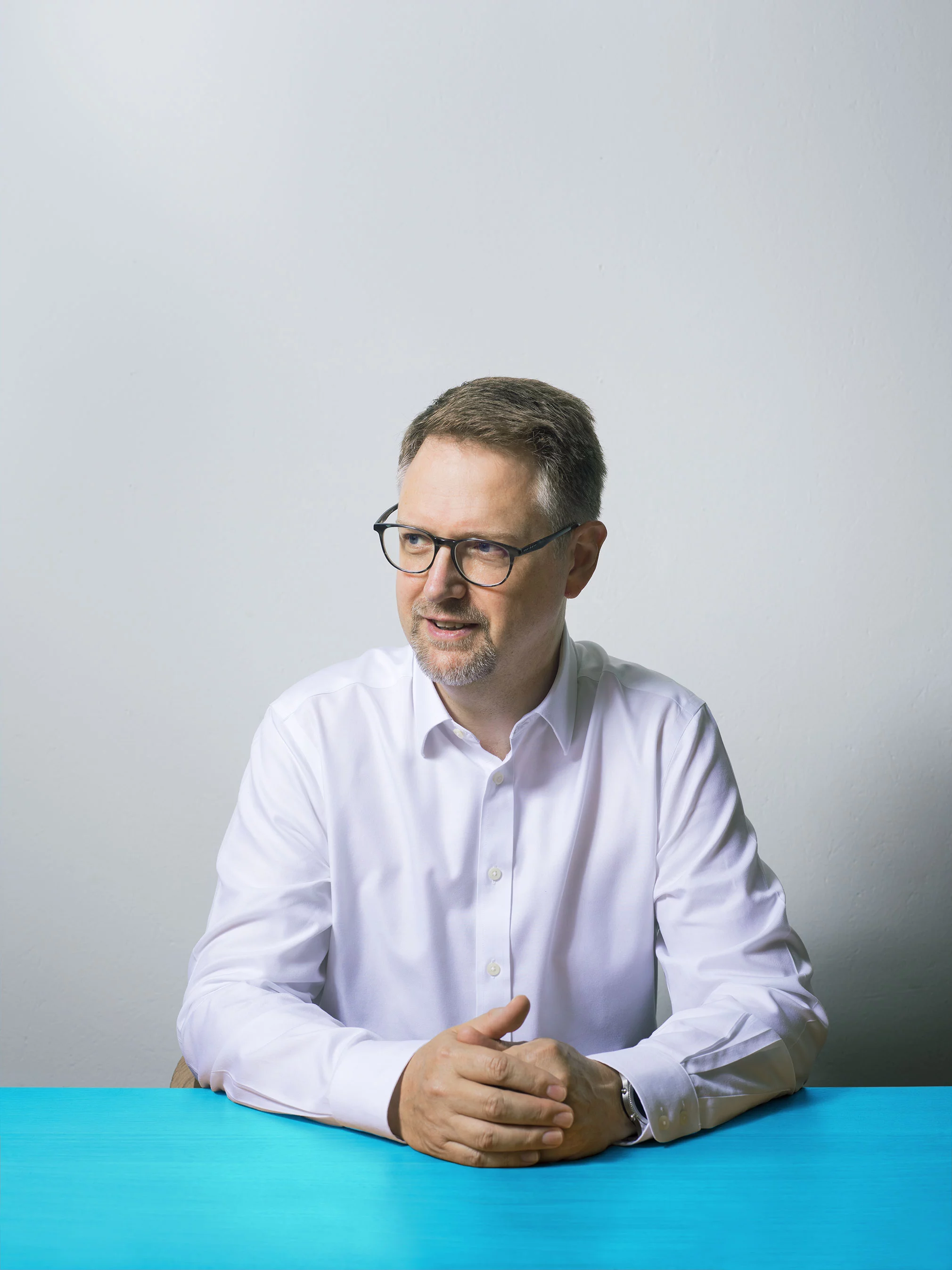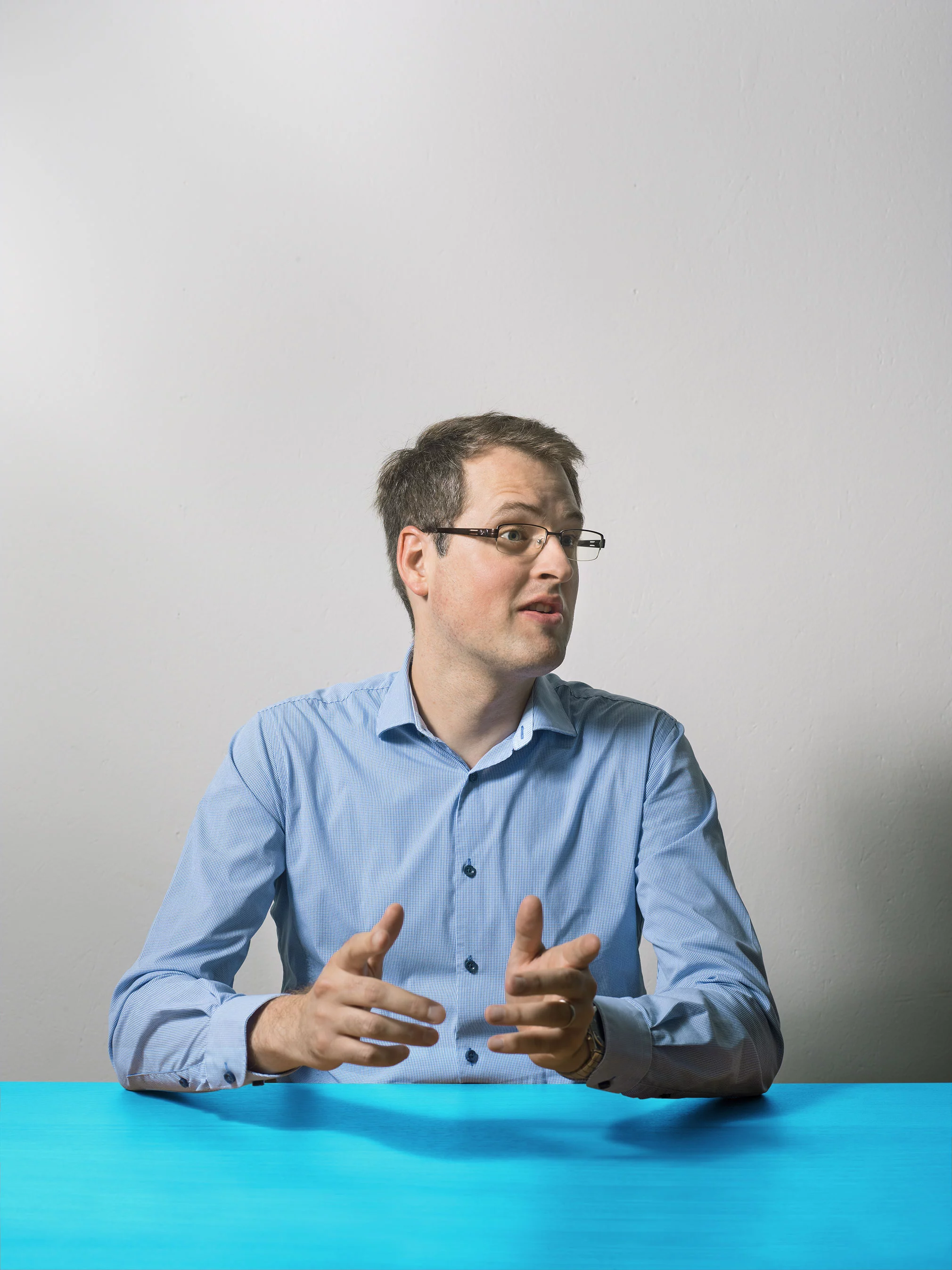Towards new shores: At the Paul Scherrer Institute PSI, enterprising researchers are venturing into the unknown. They're leaving their safe haven to become successful entrepreneurs. The journey from PSI to one's own spin-off takes courage. To keep the voyage from getting too stormy, PSI supports its business founders as they navigate through rough waters, and maintains these connections over many years.
The Aargau-based company DECTRIS has its headquarters just 12 kilometres as the crow flies from PSI. In the modern, light-flooded building in the industrial area of Baden-Dättwil, a glass lift carries visitors quietly up to the top floor. There Christian Brönnimann has his spacious corner office overlooking the green countryside. In his off-white polo shirt, khaki trousers, and training shoes, the sporty-looking DECTRIS CEO doesn't give the impression of a typical manager, yet you do get the feeling this is the look of success. Brönnimann runs a business with 110 employees, which has conquered the world market with its high-resolution X-ray detectors.
The success story began more than 20 years ago at PSI, as the young physicist was working on the development of novel detectors. These were based on the technology used in the CMS pixel detector that PSI had built for CERN. A high-sensitivity camera capable of recording every single of X-ray quantum – that was the projects’ major goal. With it the researchers wanted to capture the strong X-ray light of the newly built Swiss Light Source SLS, in order to take accurate pictures of protein molecules or other tiny structures and materials. For nine years, Brönnimann and his colleagues at PSI worked on the development of the silicon sensors, the readout electronics, and the associated software. They gave their first functional detector a name with symbolic power: PILATUS. I was driven by my fascination for this technology and the joy of developing these detectors
, Brönnimann says today. In 2005, when we had completed the first detector at PSI that gave the crystal structure of a protein rather than just spotty images, that was the absolute highlight for me.
This was also the moment when the researcher first considered setting off for new shores and building something of his own. Brönnimann turned to the technology transfer office of PSI, where he found himself knocking on doors that were already open. The most important thing: the intellectual property rights. When researchers come to us and present an idea, we first have to clarify if a technology can be patented and the intellectual property rights can be obtained. This makes it much easier for researchers to find investors if they later want to start a spin-off
, explains John Millard, head of technology transfer at PSI. The native Englishman speaks from experience: Before he started working at PSI, he had already founded and built up several companies.
In the case of the X-ray detector PILATUS, the preconditions for a spin-off were good: several patents, a product that no one else in the world was offering, and a team of four highly motivated researchers and engineers. On top of that, the project had one further advantage, namely potential customers.
This is possibly the very first thing we try to explain to people: Anyone who is thinking about a spin-off must first analyse the market and talk with potential customers
, Millard emphasises. If you don't know what the customer wants or which problems you can solve, even the best technology or idea won't do much good. If nobody buys it, there's no business.
Well-planned first steps
To avoid that, the DECTRIS founders sent up a trial balloon before stepping off into independence. PILATUS was developed by experts for experts, and its application area was the preserve of specialists at other synchrotron research facilities. The would-be entrepreneurs built and tested three prototypes of the detector at PSI to determine if, and how well, they would sell. When that went without any trouble, the decision was made in 2006: onwards to commercialisation.
The researchers set out in an optimistic mood. PSI had offered them comfortable conditions for the transition during the first two years: For the production of the first systems, they would be allowed to use the PSI infrastructure and all of the newly developed equipment. The know-how acquired at PSI was made available for their use through licencing agreements. The first two years went well. We were still together with the other PSI researchers, we received the first orders for the detectors, and we were really off to a good start
, Brönnimann recalls.
Overcoming setbacks
Then came the disillusionment, when the spin-off took the leap into cold water in 2008 and moved to Baden. While the young company received more and more orders for PILATUS detectors, production of the devices hit difficulties in the new location where the rooms were not air-conditioned. Brönnimann says, We duplicated everything that had functioned in the PSI laboratory, and it didn't work at all in Baden.
The company hit rock bottom.
John Millard from technology transfer is familiar with such low points at young spin-offs. It is perfectly normal that things don't always go smoothly, especially at the beginning of a company's independence. You try something out, fail, and start over again. You look for the flaw, find it, and change something. It's a temporary setback that you can learn from.
The DECTRIS team, too, adopted systematic trouble-shooting. This analysis and solution approach to solving problems was very familiar to the former PSI scientists from their research days.
Seizing the opportunity
Today Brönnimann can only laugh about the difficulties they had in the beginning. After three-quarters of a year, the devices worked flawlessly and their own production could start. Since then, the company has continuously increased its sales and produced even better detectors. The latest product family, called EIGER2, runs roughly 100 times faster than the PILATUS model that the company originally delivered. In his office, Brönnimann points to a metal plate the size of a beer bottle cap that gleams like gold, with 16 tiny circuits attached to its underside. This is what a modern X-ray detector looks like before it is installed in the associated housing.
Brönnimann says of himself: I didn't originally want to become an entrepreneur, but I saw the enormous potential and took advantage of the opportunity.
With this attitude, he has come a long way with his DECTRIS team. The company has won the Swiss Economic Award, the Aargau Enterprise Award, and the Prix SVC, and it is firmly anchored in the regional business community. The company's upswing benefits not only local suppliers, but also PSI: For every device sold, licence fees flow to PSI and thus support further research activities. Already in 2017, the company set up a branch in the USA, and the expansion continues. In the future, DECTRIS wants to establish itself more strongly in market areas outside the current niche market of synchrotron operators: in the laboratory market and in the field of electron microscopy.
To commemorate the early years, an old PILATUS module stands on a sideboard in Brönnimann's office, next to a volleyball – a birthday present for the CEO – signed by the entire workforce of DECTRIS. If the company keeps growing like this, one ball won't be enough for his next birthday.
Breeding ground for entrepreneurial ideas
DECTRIS is the largest of several successful spin-offs that have emerged from PSI. The oldest of these is SwissNeutronics. For nearly 20 years, the company has been producing neutron guides in Klingnau, close to PSI, and likewise covers a specialist market segment. As in the case of the X-ray detectors, the technology stems from research at PSI. When the neutron source SINQ was built there in the 1990s, resourceful specialists associated with neutron researcher Albert Furrer – now an emeritus professor at ETH Zurich – developed the urgently needed neutron guides themselves and, later, brought them to market with their own company.
The large research facilities in Villigen offer unique opportunities in the pursuit of new knowledge, and at the same time they are also a breeding ground for creative entrepreneurial ideas and innovative products or services. That inspires Millard: Our core competence, next to the science, is the construction and operation of complex large research facilities. The developments that arise from that, and the components for these facilities, can't be bought wholesale. These are mostly custom-made products realised in close cooperation with industry – born out of necessity, either because nothing suitable exists yet or because you want to make something better. And that leads to innovation.
Many PSI spin-offs have their origins in fundamental research. One of these is the young company GratXray, founded in 2017 by researcher and ETH Zurich professor Marco Stampanoni together with three colleagues and PSI. This start-up aims to establish nothing less than a new gold standard in the early detection of breast cancer, using a method originally developed at PSI for the characterisation of synchrotron radiation. GratXray has its headquarters in Park innovaare, which is currently being built up in the immediate vicinity of PSI. In its first building, a modern grey pavilion, far-sighted vision is guaranteed. Behind the extensive glass facade are the offices of companies that want to commercialise innovations in the fields of medical and pharmaceutical research, materials research, energy, and accelerator technologies – in close collaboration with PSI or as PSI spin-offs.
Chance discovery leads to a business idea
Philipp Spycher, from the Centre for Radiopharmaceutical Sciences at PSI, also hopes to set up headquarters in Park innovaare. He came to Villigen in 2014 as a postdoctoral researcher. Since that time he has been investigating antibody-drug compounds that could selectively transport the active agent to specific cells in the body. The young nanobiotechnologist experienced the kind of chance discovery that many researchers dream of: During the analysis of an antibody compound by mass spectrometry, an extra spike appeared on the screen that had never been there before
. That aroused his curiosity. Several experiments and a few weeks later, it was clear to him: This is something sensational. Spycher had discovered a kind of glue. With it, antibodies and agents can be easily and precisely attached to each other without having to be chemically modified. The scientist quickly realised the potential of his discovery: Pharmaceutical companies could save a lot of time and money.
Founder Fellowship supports the entrepreneurial spirit
Then Spycher got lucky for the second time. The Founder Fellowship had just been launched at PSI. This funding instrument is intended to support researchers with the entrepreneurial spirit on their way to founding their own companies. One prerequisite: The technology they want to bring to market must have been developed at PSI. John Millard explains: The fellowship allows the scientist to continue developing his or her technology in a paid position for up to a year and a half, talk with potential customers, and seek out team members. The winners receive coaching and attend courses for entrepreneurs. There they learn the basics needed to found a business.
Five candidates, including Spycher, applied for the Founder Fellowship in the first round. With the support of his supervisor and the pros in technology transfer, the researcher analysed the benefits, costs, and risks of his business idea and successfully defended it before an external jury representing both research and business.
The latest spin-off is now being formed
The young nanobiotechnologist is in a hurry to embark on his entrepreneurial career. Having just won the Founder Fellowship and a stipend for the next 18 months, he already has the first customers and wants just one thing: to found his company. The first big pharmaceutical companies have already come knocking on the door. This is a comfortable starting position, the kind that makes investors much more likely to invest in a start-up. Spycher's enthusiasm for his new path is clear. Still a researcher and soon to be an entrepreneur, he has recruited his first employee and has given his company a name complete with Internet presence: Araris Biotech AG. Just a few years ago, the researcher could not imagine quitting science and becoming an entrepreneur. But now the entrepreneurial spirit has taken hold: With my own company, a new world is really opening up that I didn't know before.
The success story of a new PSI spin-off has begun.
Text: Sabine Goldhahn




